As one hugely popular television show is very keen on reminding us, winter is coming, meaning colder weather, longer nights and a desire to take solace in comfort food.
Dealing with terrible weather is something us Scots have become invariably used to, meaning we've developed some excellent ways of coping, and being Scots, that usually means food.
Not only have we adapted to use the wonderful ingredients available to us, we also know how to get the most we can out of them.
Usually a meal in itself, hairst bree, the old Scots for harvest broth, is what Scottish food historian Fraser Wright describes as a "perfect example of cooking at its most elementary" - a cheap cut of meat on the bone simmered in water until it is melting and soft, before plenty of delicious vegetables are added to give you a nourishing one pot dish that can feed you for two or three days.
(based on The Cookery Book of Lady Clark of Tillypronie, first published in 1909)
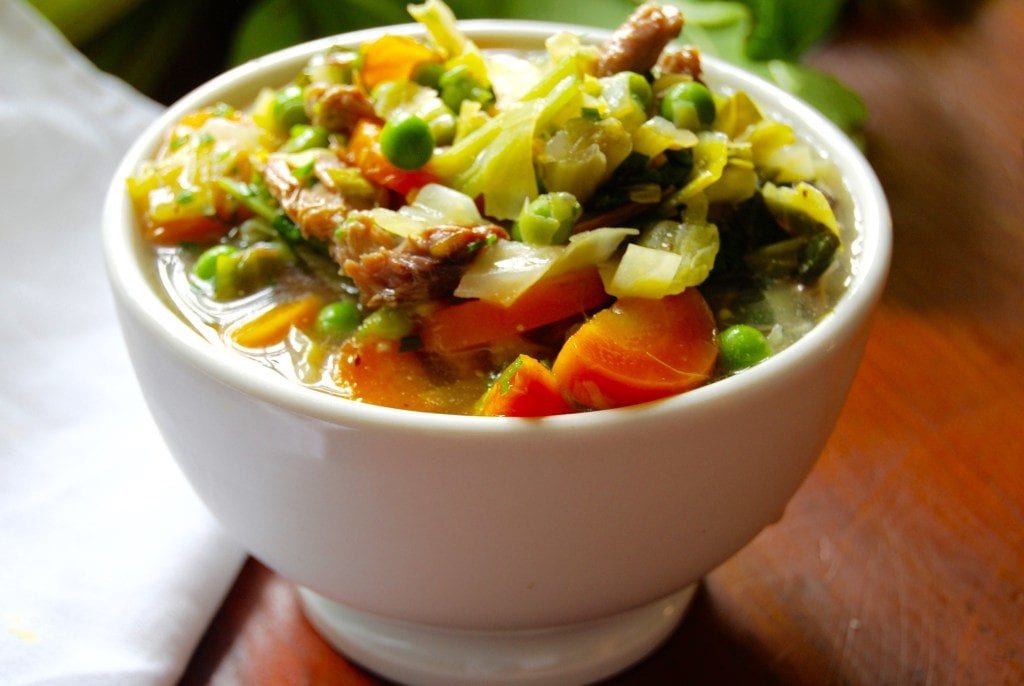
Picture: Fraser Wright
Ingredients:
• 800g lamb neck (split in two if you can get it) or another cheap cut of lamb on the bone
• 500g peas in the pod, podded
• 1 sweetheart cabbage, shredded
• whole bunch spring onions (8-10 spring onions), sliced into small logs
• 2 lettuce heads (little gem), shredded
• 3 carrots, sliced (some old recipes suggest grating it)
• 2 bay leaves
• 2 cloves
• A bunch of chopped soft herbs to garnish such as mint, chives, parsley
• sea salt
Method:
Put the meat in a large pot and cover with cold water, add a generous helping of salt and two bay leaves.
Slowly bring to the boil and simmer for 1 – 2 hours.
You may need to top the water up if it gets far below the meat.
Occasionally remove the scum with a metal spoon.
Never let it boil so the scum doesn’t get a chance to boil back into the stock.
When the meat is soft remove it to a dish. While it is cooling prepare the vegetables.
When the meat is cold enough to handle shred it into bitesize pieces, getting rid of any gristle. It is easier to do this when the meat is still warm.
Put the tougher vegetables into the pot with the lamb broth (carrots, cabbage) and simmer for 20 minutes.
Now add the peas, lettuce and spring onions and cook for another 10 minutes. Check for seasoning and finish with the chopped herbs.
A Scottish favourite for centuries, recipes for cock-a-leekie go back at least as far as the 16th century and, in many older versions, the chicken was apparently served whole, sitting in the soup.
Leeks were more than likely introduced into Scotland by the Romans and have become a popular ingredient in the national diet ever since, and some traditional recipes for this soup recommend the addition of prunes, an ingredient that has perhaps fallen out of fashion of late.
Top Scottish chef Tom Kitchin recommends leaving them in as they "add a rich, deep flavour".
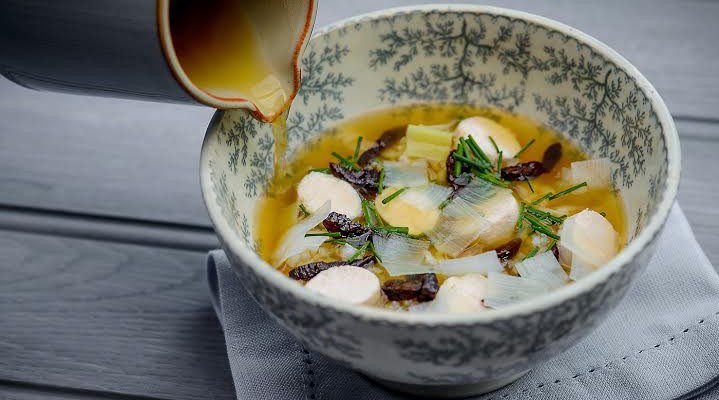
Picture: Marc Millar
Ingredients:
For the stock:
• 1 whole free-range chicken
• 1 onion
• 2 carrots
• 1 sprig thyme
• 5 white peppercorns
• 1 bay leaf
• Salt
For the garnish:
• 200g basmati rice
• 50g chopped prunes (optional)
• 20g chopped parsley
• 1 chopped leek
Method:
For the stock
In a large pan cover the chicken with cold water and bring to the boil.
Add the vegetables and herbs and cook slowly for two or three hours until the chicken is cooked.
Remove the chicken and vegetables from the stock and season to taste.
For the garnish
Meanwhile, cook the basmati rice and chopped leeks in boiling salted water.
Chop the prunes and parsley, keeping aside for garnish. Break away the chicken from the bone.
To serve
In a bowl place the cooked rice, chicken, prunes and chopped parsley. Cover in stock and serve.
More commonly known around the world as crab bisque, partan bree is a classic dish from the North East, which takes it name from its ingredients – partan being the Gaelic and Scots for crab and bree a Scots term for soup.
Given that rice isn’t grown in Scotland, the recipe most likely dates to the period in which it first became available – around the latter half of the 18th century when trade, mainly through the East India Company, brought it to these shores.
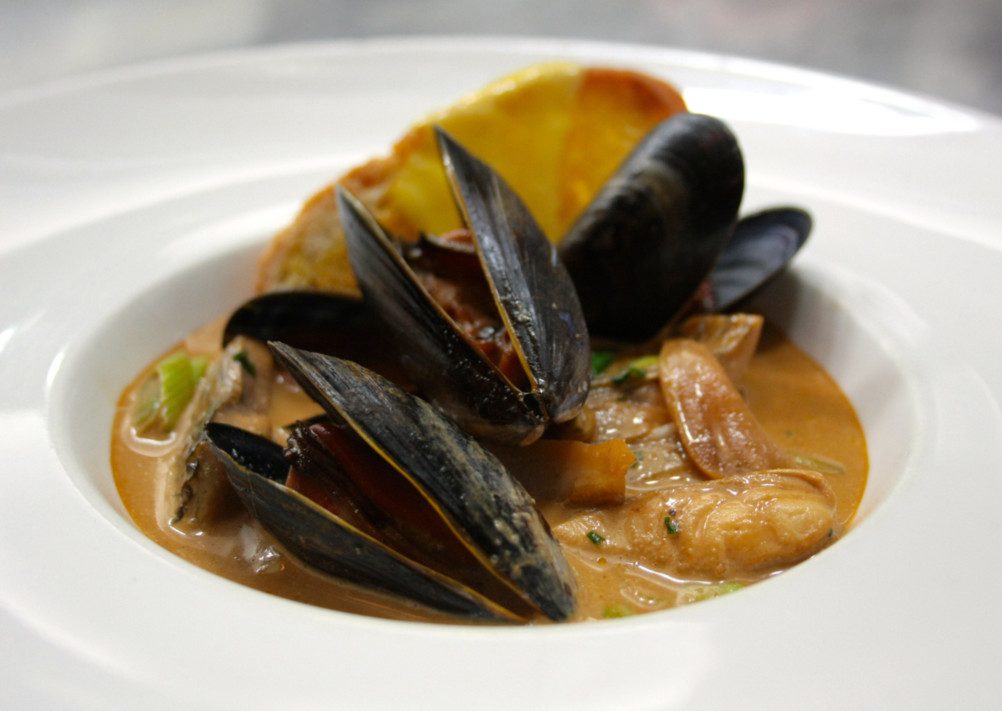
Picture: Contributed
Ingredients: (serves 4)
• 1kg prawn and/or crab shells
• 1 large onion, roughly chopped
• 1 large carrot, roughly chopped
• 1 stick celery, roughly chopped
• 1 fennel bulb, roughly chopped
• 250g mixed fish, such as hake, pollock or salmon tails, cut into inch cubes
• a large handful of mussels
• 100ml double cream
• 4 tbsp good mayonnaise
• 30ml Pernod or Ricard
• 1 tbsp tomato purée
• 2 pinches saffron
• 1 clove garlic, crushed
• 1 bay leaf
• 1 tsp peppercorns
• 1 tbsp rapeseed oil, plus extra for the mayonnaise mix
• salt and pepper
• 4 slices good bread for toasting
Method
In a hot oven, roast the shells for about half an hour on a roasting tray, until you can smell them.
Meanwhile, on the hob, heat the rapeseed oil in a large pot and fry the carrot, onion, celery, half the fennel, peppercorns and bay leaf until golden.
Then add the tomato purée and keep frying to cook out the purée. Add the roasted shells and cover with water.
Simmer on the hob, stirring occasionally and making sure there’s always enough water.
After a couple of hours, push the stock through a fine sieve, ensuring no shell remains.
Place a clean pot on the hob, add the Pernod or Ricard and reduce by half.
Now add the stock, and reduce by half again until strong and rich.
Incorporate the cream and a pinch of saffron to the stock and bring to the boil.
Reduce further for a few minutes until it looks creamy.
Then add in the fish and the mussels in their shells and cook on a gentle heat (do not boil now, as the fish will break up and go mushy).
Whilst your bread is toasting, make a rouille by mixing together the garlic, mayonnaise, saffron and a squirt of rapeseed oil.
If you have a spoonful of leftover mash or bread crumbs, you can also add this to the mix.
Taste the soup and season to taste.
Serve in warmed bowls with dollops of rouille and the remainder of the fennel on top (if you like that aniseed flavour), and toasted bread on the side.
Comforting and creamy yet full-flavoured, Cullen Skink is a soup of smoked haddock, potatoes and onions.
Traditionally made with water, but now arguably enhanced by the addition of milk or cream, the soup originated in the town of Cullen in Moray (where haddock abound), with the word “skink” originally meaning “shin of beef” in Scots and then coming to mean soup or stew.
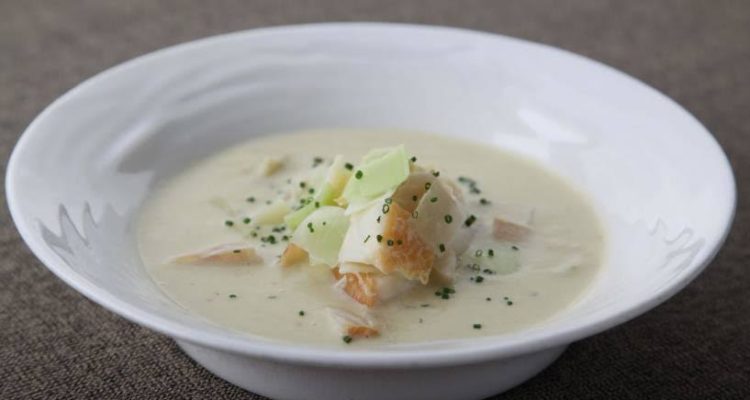
Picture: TSPL
Ingredients:
• 1 tbsp olive or vegetable oil
• 1 leek, well-rinsed, chopped and cut into rough 2cm cubes
• 1 litre fish stock
• 200g waxy potatoes, peeled and cut into roughly 2cm cubes
• 300g undyed smoked Scottish haddock fillet
• 1 bay leaf
• Freshly ground pepper
• 2 tbsp whipping cream
• Chives, roughly chopped
Method:
Warm the oil in a pan.
Add the chopped leek, cover and gently cook for a few minutes until soft.
Add the stock, bay leaf, potato and haddock. Season lightly with black pepper.
Bring to the boil and simmer for 15 minutes. Remove the haddock from the pan with a slotted spoon.
When the fish is cool enough to handle, remove any skin and bones, then flake the haddock back into the pan.
Blend a ladle full of the soup in a liquidizer and return to the pan.
Stir in the double cream and simmer for another 2-3 minutes.
Add more black pepper if necessary, then sprinkle with the chopped chives and serve.
Serve with chunks of fresh wholemeal or granary bread.
Perhaps the epitome of a traditional Scottish soup. The best seems to contain everything and anything, but two essential ingredients are mutton and barley.
Good Scotch broth should be more like a stew than a soup, with the kind of consistency that will "line your stomach".
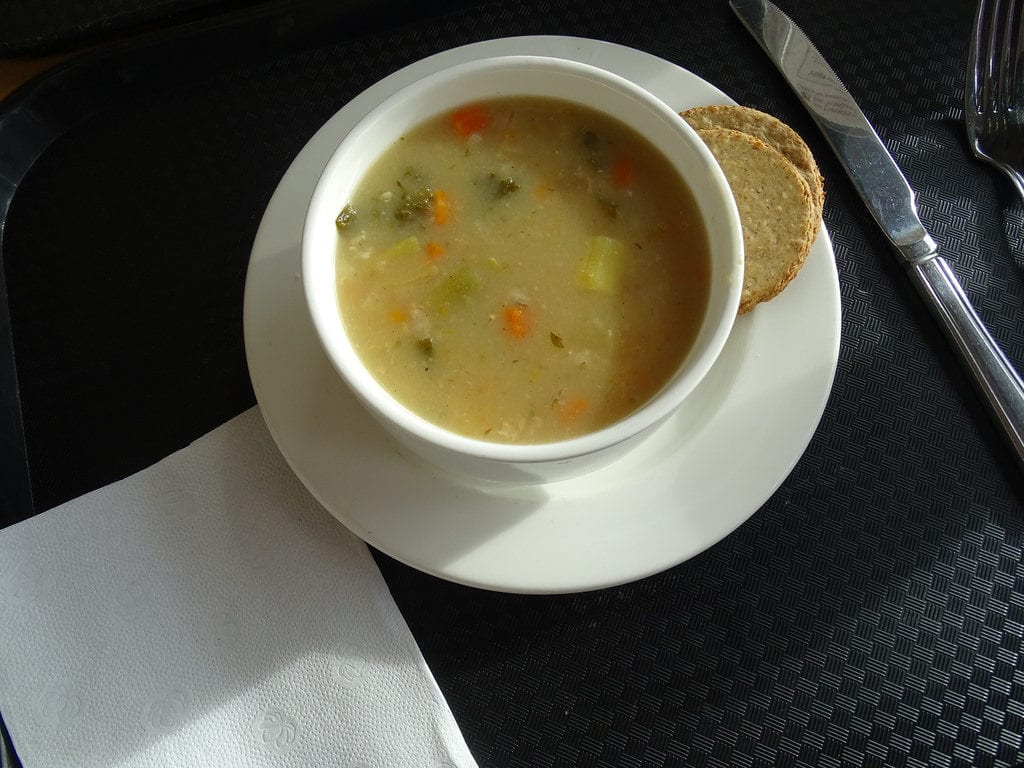
Picture: Flickr\Odile Blanvillain
Ingredients:
• 800g lamb on the bone
• 3 medium sized carrots, peeled, diced
• 1 turnip, diced (or a swede which would be more traditionally used in Scotland)
• 2 onions, peeled, diced
• 1 leek, white part only, sliced
• 100g pearl barley
• 100g dried peas, soaked in water for 4-5 hours, drained
• salt
• freshly ground black pepper
• Chopped parsley
• One splash of Scotch whisky (optional)
Method:
Place Lamb in a large pan and cover with water, place heat to around medium.
Dice the turnip, 1 of the carrots and the onions, grate the other 2 carrots and slice the leek.
When the pot is simmering add the above veg and skim off any froth as it cooks.
Rinse the barley and peas (post soak) and add to the pan together with the chopped parsley.
Leave to simmer for around 2-3 hours, remembering to stir occasionally and skim of fat and froth with a wooden spoon.
Add the salt and pepper.
Stir more often towards the end of cooking time as barley may stick to base of pan.
Remove the lamb 15mins from the end and let it cool a little before removing the meat from the bones. Discard the bones.
Cut the meat into small pieces and add to the soup.
Taste the soup, season with salt and pepper if necessary and serve.
'Sheep heid' broth is a recipe that has not survived the test of time. This was a barley broth cooked with a singed sheep's head. Traditionally, it was served with the sheep's head in the tureen.
Jassintour Rozea, chef to the Earl of Hopetoun, gives a recipe for 'Barley broth a L'ecossaise or Sheep heid broth the Scots way' in his book 'The gift of comus, or practical cookery' of 1753.
He comments: '… it makes a monstrous smoke and stink in the kitchen … King James was the first that ate a sheep head dressed this way in England.'
Turtle Soup was an extravagant 18th century soup. Even the élite substituted a calf or sheep's head stewed in strong stock and fortified with wine.
Martha Bruce's lemon-flavoured version was a substantial dish with meat balls and hard boiled eggs.
Clear Mock Turtle Soup, a light version of the classic dish, was served at society dinners.
